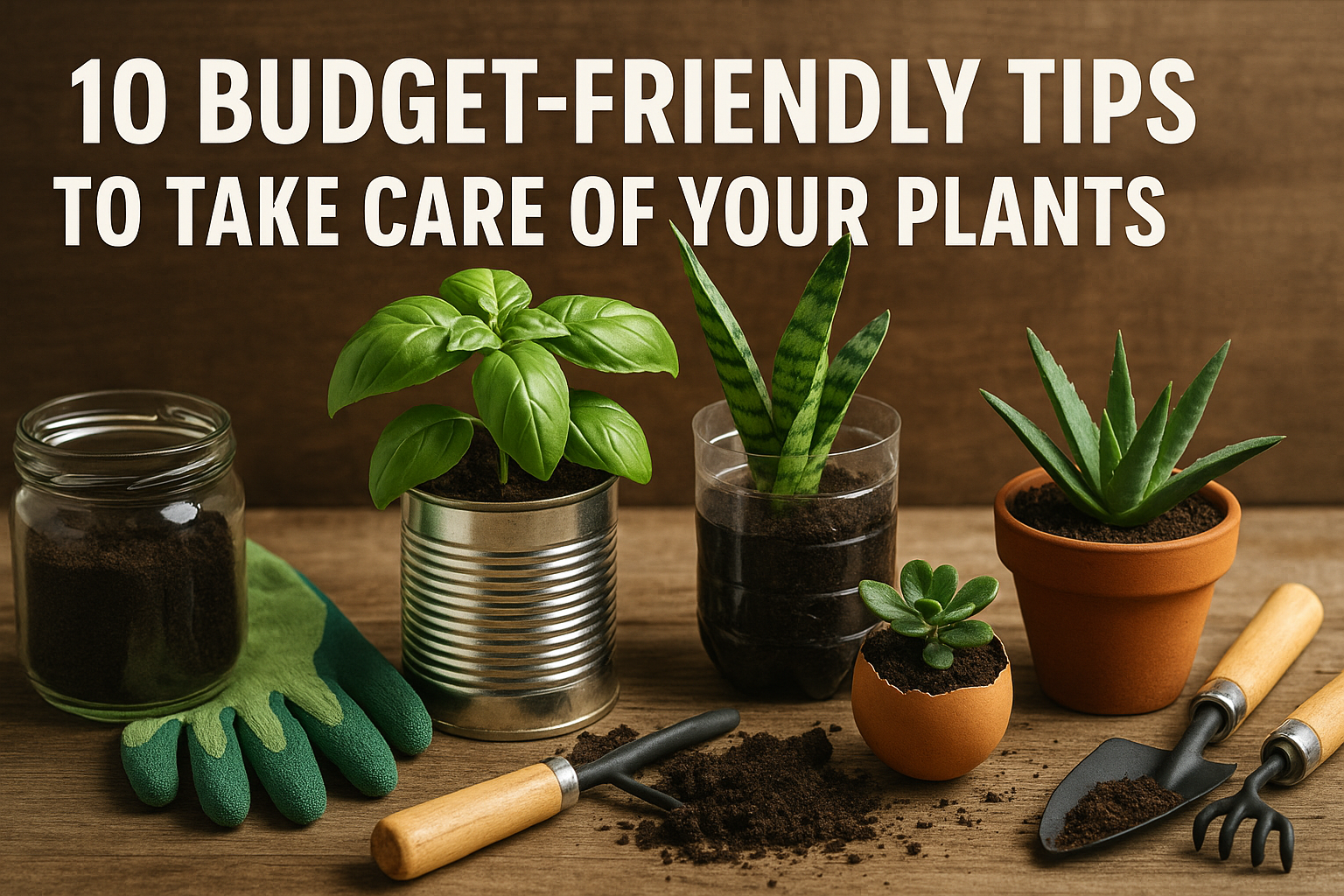Taking care of plants doesn’t have to be expensive. Whether you’re a beginner or someone trying to expand your indoor jungle or backyard garden, there are simple and affordable ways to ensure your plants thrive. These 10 practical tips will help you care for your plants without stretching your budget.
1. Use Household Waste as Natural Fertilizer
Instead of buying store-bought fertilizers, turn your kitchen waste into plant food. Many common food scraps are packed with nutrients that plants love:
- Banana peels: Great source of potassium and phosphorus.
- Coffee grounds: Add nitrogen to the soil and are perfect for acid-loving plants.
- Eggshells: Crushed eggshells are rich in calcium and help prevent blossom-end rot in tomatoes and peppers.
- Vegetable scraps: Blend peels and leftover veggies with water to make a nutrient-rich liquid fertilizer.
These homemade fertilizers reduce waste and keep your plants healthy for free.
2. Water Smartly with Reused Water
Watering plants can increase your utility bills, but you can reuse clean household water to save money:
- Collect water from rinsing fruits and vegetables.
- Save rainwater in buckets or barrels.
- Use leftover water from boiling eggs or vegetables — just make sure it’s cooled and unsalted.
This eco-friendly habit keeps your plants hydrated and your water bill low.
3. Propagate Your Existing Plants
Propagation allows you to multiply your plants without spending anything. Many houseplants and herbs can be propagated easily:
- Stem cuttings: Snip a healthy section of the plant and place it in water or soil. Plants like pothos, basil, mint, and coleus root very easily.
- Leaf cuttings: Succulents like echeveria and jade can grow new plants from a single leaf.
- Division: Split plants like aloe vera or ferns into multiple pots.
This is a great way to expand your plant collection or even swap with friends.
4. Upcycle Everyday Items as Planters
Instead of buying new pots, repurpose items you already have:
- Cans, jars, and bottles: Perfect for small herbs and succulents.
- Old mugs, bowls, and buckets: Great for creative container gardens.
- Plastic containers: Yogurt cups or takeout containers can be reused for seedlings.
Just be sure to add drainage holes in the bottom, and you’ll have functional (and unique) planters.
5. Make Your Own Compost
Compost enriches your soil and saves money on fertilizers and soil conditioners. Even in small spaces, you can compost:
- Use a bucket or bin with a lid.
- Combine “greens” (fruit and vegetable scraps, coffee grounds) with “browns” (dry leaves, shredded paper, cardboard).
- Turn the mix every few days to help it break down.
In a few weeks to a few months, you’ll have dark, crumbly compost to feed your garden naturally.
6. Create a Mini Greenhouse Using Plastic Bottles
Protect your seedlings from harsh weather and pests by creating mini greenhouses:
- Cut large plastic bottles in half.
- Place the top half (with the cap removed) over your young plant.
- This creates a warm, humid environment that helps seeds and seedlings grow faster.
This trick works especially well for balconies and small container gardens.
7. Use DIY Pest Control Solutions
Commercial pest control products can be expensive and harmful. Try these natural, budget-friendly alternatives:
- Soap spray: Mix a few drops of dish soap in water and spray on plants to eliminate aphids and mites.
- Garlic or chili spray: Blend garlic or chili with water to repel insects.
- Neem oil: Although it may require a small upfront cost, a little goes a long way and it lasts for months.
These options keep your plants safe without breaking the bank or harming the environment.
8. Choose Resilient, Low-Maintenance Plants
If you’re new to gardening or have a tight schedule, start with plants that don’t require constant care or expensive supplies. Great low-cost, low-effort options include:
- Snake plant (Sansevieria)
- Aloe vera
- Spider plant
- Zebra plant
- Pothos
- Succulents
These plants are perfect for beginners and can thrive with minimal attention.
9. Join Local Plant Swaps or Online Groups
Gardening communities are a treasure trove of support and free resources. You can:
- Swap seeds or cuttings with other gardeners.
- Ask for tips specific to your region.
- Find free events, giveaways, or group purchases of soil or tools.
Look for Facebook Groups, Reddit communities, or even neighborhood apps like Nextdoor.
10. Stay Consistent and Observe Your Plants
Even with all the best tricks, one of the most powerful (and free) tools you have is observation. Look at your plants every day — check for:
- Yellowing leaves
- Dry or soggy soil
- Pests like small bugs or white spots
- Drooping or curling leaves
By catching problems early, you can avoid plant loss and costly solutions later.
The Benefits of Low-Cost Plant Care
When you take care of your plants on a budget, you’re not only saving money — you’re becoming more connected to the environment, developing useful life skills, and reducing waste. Plus, the creativity required to garden with limited resources often leads to beautiful, unique setups that reflect your personality and effort.
The more you practice, the better you get — and the more rewarding your green space becomes. Whether it’s a windowsill full of herbs or a backyard full of repurposed planters, your garden can flourish, even with the smallest budget.
